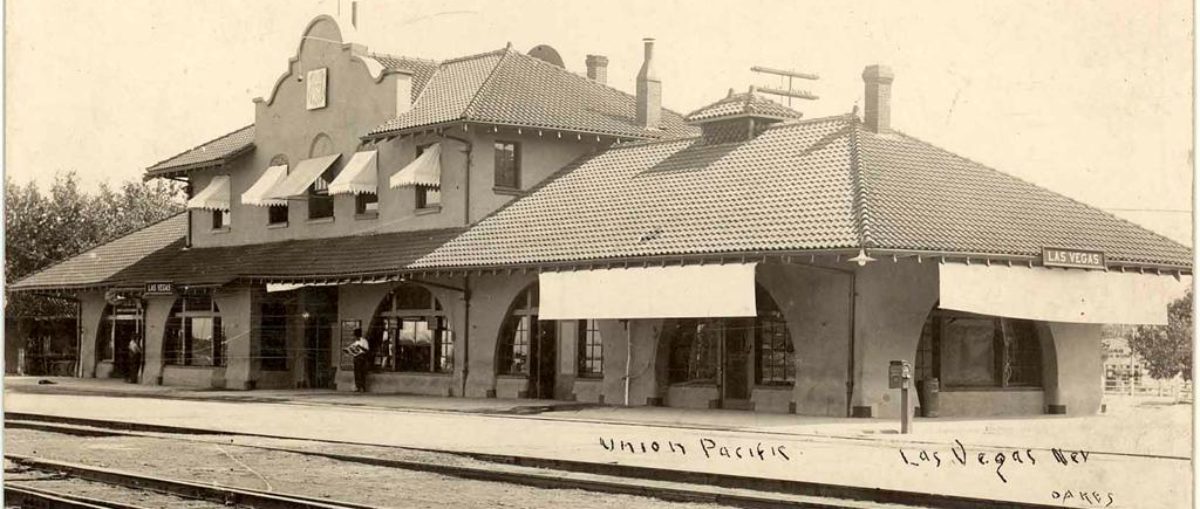Neon in Las Vegas 1928 to 1930, the First 14 months.
(Updated April 17, 2021)
Preface. In 2011, Dorothy Wright and I were serving on the City of Las Vegas Historic Preservation Commission. Dorothy, who fought for years to preserve the history of Las Vegas, was in the final draft of her manuscript on Neon signs in Las Vegas.
In researching early aviation history in Las Vegas I bumped into a small newspaper article about a Neon sign. I mentioned it to Dorothy and she asked for the clipping.
The reference is found on page eighteen of the book “Spectacular, A History of Las Vegas Neon,” written by Dorothy, Melissa Johnson and Carrie Schomig.
Recommendation, their important work provides a detailed look at the full history of Neon in the Las Vegas area. Both a good read and reference work.
They write, “The Overland was, if not the first, certainly one of the first neon signs in Las Vegas.” The same paragraph provides a brief look at signs in the late 1920s before moving on to the 1930s.
At that point, we began tossing notes into a file, First Neon signs in Las Vegas which is the basis for this multi-chapter story detailing the early days of Neon in Las Vegas.
Chapter one, starts in September of 1928 and ends in December of 1929. During this brief period, Las Vegas would see the first glow of Neon signs, as well as the beginning of the battles over whose Neon display was bigger and brighter.
Research reveals the Neon sign on the Overland Hotel was in fact the first, and ten more signs would go up in Las Vegas by the end of 1929.
(All the images in this story are from the author’s collection)
THE FIRST NEON SIGN IN LAS VEGAS
Las Vegas in the winter of 1928 was weeks away from becoming known around the world.
At the moment, however, all was unusually quiet in the normally wide-open desert outpost.
The prohibition against the sale of alcohol in the United States was still the law, and in Nevada, most forms of gambling were also illegal.
But since its founding in 1905, law enforcement in the areas of liquor, gambling, and prostitution was done with a wink and a nod.
However, starting in the middle of 1928 through early 1929, a heavy lid was placed on illegal gambling and the sale of alcohol.
The “King of the Las Vegas Underworld,” was in jail, the Las Vegas Chief of Police had resigned in disgrace, and the Mayor was about to be busted by federal agents, and face a recall for crimes related to the other two men.
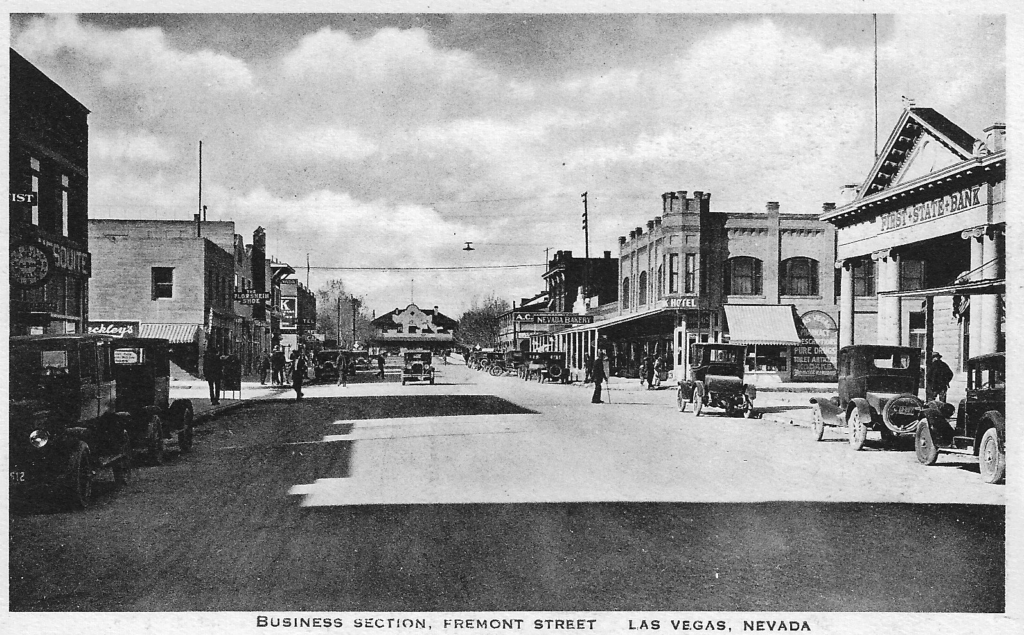
ca. 1928 Post card of Fremont Street looking west.
For most Las Vegans, despite the cool winter days, and the government scandals, a bright future was in the air.
After nearly a decade of debate, the United States Congress appeared ready to approve a bill to build a massive dam across the Colorado River, not far from Las Vegas.
On December 18, following a 166 to 122 vote in the U.S. House of Representatives the legislation was sent to President Calvin Coolidge.
Seventy-two hours later, the President signed the Boulder Canyon Dam bill.
In a story sent nationwide by the Associated Press wire service, “shot-guns and frying pans were pressed into service as noise makers” in Las Vegas “by a joy-mad populace that turned out to celebrate.”[i]
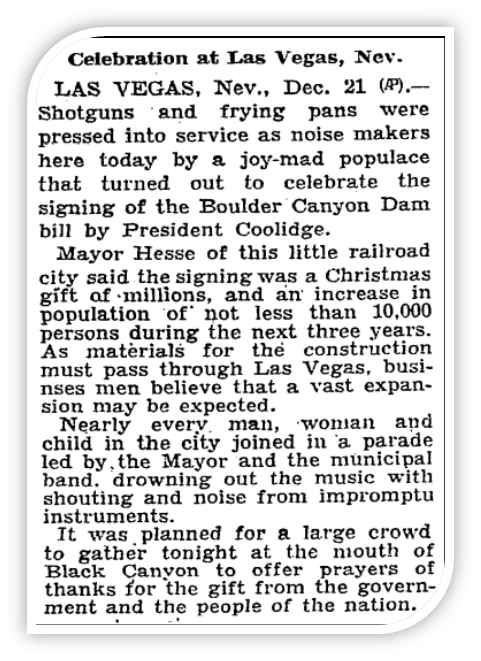
Not only were “joy-mad” locals excited, so were, and using the broadest definition of the word possible, ‘entrepreneurs,’ who saw the light at the northern edge of the Mojave desert.
They were all on their way. Real estate speculators, business owners, construction workers, and those who saw the empty shoes of the King of the Las Vegas underworld as an opportunity.
Clark County Sheriff Sam Gay received a letter from a company saying, “When Boulder Dam is built, you’ll need a bigger jail, let us build it for you.”
Las Vegans who had been living with the ups and downs of dam possibility began feeling in early the year the project would get the green light.
Ethel Guenter was the owner of The Overland, one of the two large hotels in Las Vegas. [ii]
Late in August of 1928, she felt it was time to improve the marketing of the Overland. One of Guenter’s answers included the word Neon.
The hotel was in a prime spot located on the northeast corner of Main and Fremont. On the other side of Main was the Union Pacific Railroad passenger depot.
However, across Fremont Street, on the southwest corner was the Guenther main competition, the Hotel Nevada, now the Golden Gate Hotel.

Of the two, the Hotel Nevada was a bit more upscale.
The Overland catered to business travelers as well as those traveling by bus. The hotel had a “Large Free Sample Room” where salesmen could display their wares. A trans-state bus stop was located on the Fremont Street side of the hotel
There were no companies in Las Vegas in the fall of 1928 that provided signs with tubes filled with the rare-earth gas Neon.
Either Guenther saw an advertisement in a Salt Lake City, or Los Angeles newspaper, or she ordered it from a traveling sign salesman. In August she placed an order for a simple Neon sign.
And Guenther knew exactly where she wanted it installed.
A month later, the following story appeared on the front page one of the September 28th Las Vegas Review newspaper.[iii]
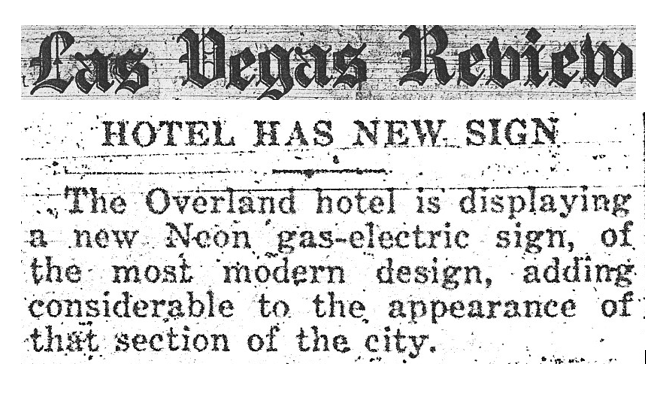
The double-sided sign contained the words “OVERLAND HOTEL.” But only the word “HOTEL” was fashioned out of the tubes filled with Neon.
It is not known if the word “HOTEL” flashed on and off, or the color. Likely tubes likely glowed a reddish-orange, the natural color of Neon.
What is known is the sign, with the eight to 10 inches tall Neon letters, left an impression on the reporter who wrote the sign adds “considerable to the appearance of that section of the city.“[iv]
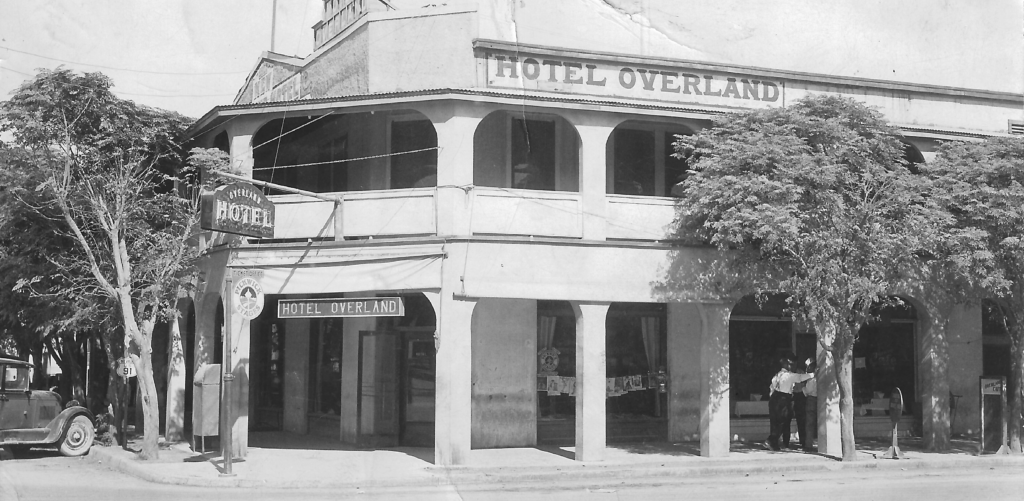
The new neon sign hung down from a pole extended from the corner of the hotel horizontally over the sidewalk.
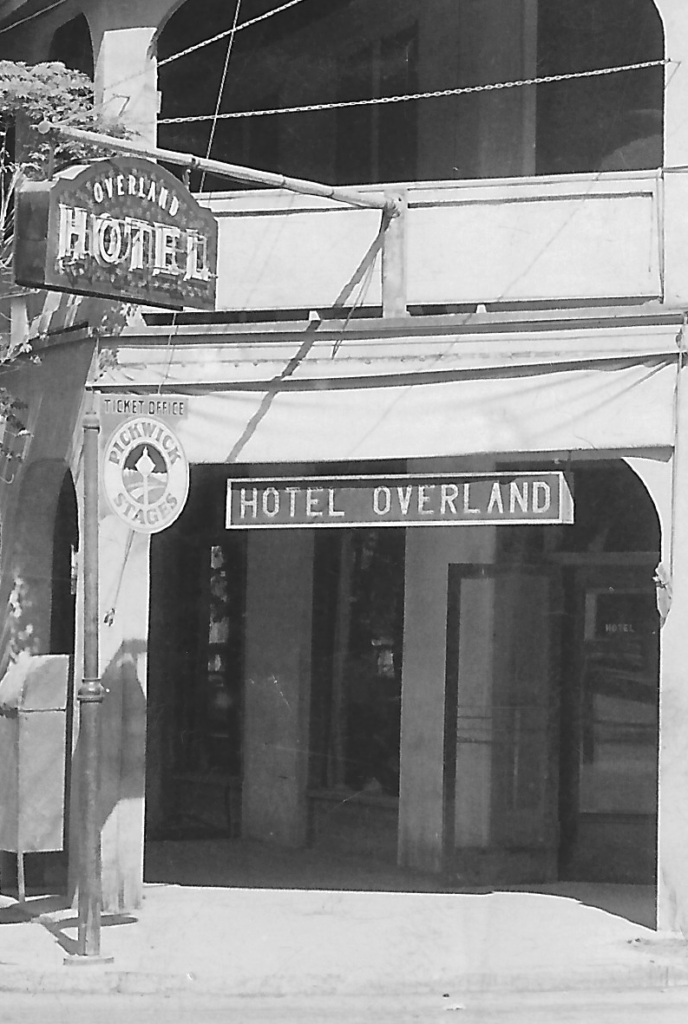
A review of the cities other newspaper, the Las Vegas Age, published by Charles and Delphine Squires, for the months of September and October, 1928, revealed no reference to Neon, or the new sign at the Overland Hotel.
Therefore, the award for the “First Neon Sign” in Las Vegas goes to Ethel Guenter and her Overland Hotel, September 28, 1928.
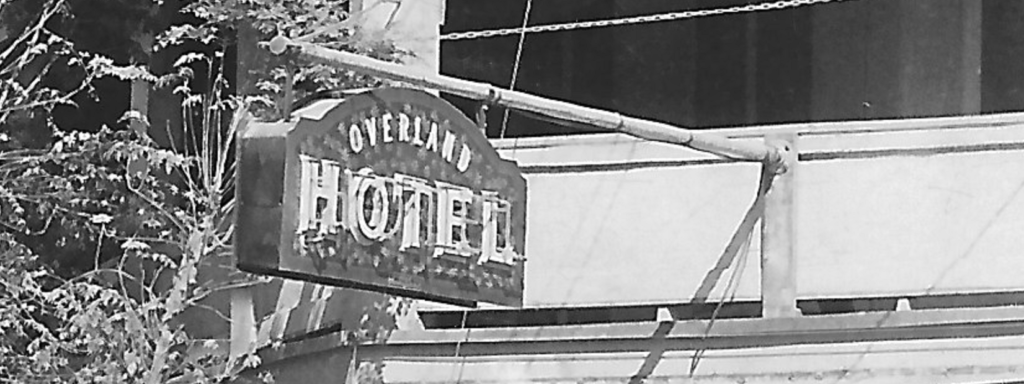
Pause for a moment with a However!
There is a ‘however’ to this historical award. It comes from newspaperman Squires who arrived in Las Vegas in 1905.
In 1948 Squires said he believed the first Las Vegas Neon sign was installed “about 1928.” [v]
He thought the first Neon sign that went up was installed on the southwest corner of Second and Fremont, where the Golden Nugget is now located.
Squires said there was “a cigar store operated by Jimmie Powers and Bob Griffith.”
It was the Mission Cigar Store. And according to Squires “there the first Neon sign in Las Vegas blossomed out with the one word, “Cigars” standing out from the building about four and one-half feet in length.”[vi]
Likely Squires kept track of stories in his own newspaper and not that of his rival the Las Vegas Review-Journal.
Squires remember what he printed, in the summer of 1929, but it was a good six months after the Overland Hotel’s sign went up.
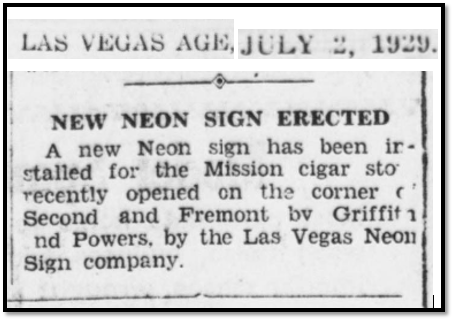
A photograph, ca 1930, of the corner reveals the letters in the sign were all upper case; “CIGARS”

Squires added, the Neon sign created “quite a blaze of light for the little town and we all figured they would have to sell a lot of cigars to pay for it.” [vii]
He said the second Neon sign in Las Vegas was “a small one on the M. W. Davis Jewelry store which read simply “Jewelry.” [viii]
Squires’s “small” description may have been based on a comparison of the 1929 Davis sign to the much larger Neon signs along Fremont Street when he made his comments in 1948.

After Cigar and Jeweler Squires said, “there was a fever of Neon signs, each one larger and more artistic, beautiful and brilliant than its predecessor.” [ix]
There is a, however,’ to the Squires ‘however.’
In early April, 1929, Alexander Barrett, described at the time as a “neon expert” and his partners opened the Las Vegas Neon Electric Sign Company.
Nine months later, on January 1, 1930, the company advertised it had created several of the Neon signs in town. On the list of signs, The Mission Cigar Store and M. W. Davis Jeweler Company.[x]
If the Las Vegas Neon Electric Sign Company didn’t open its doors until the spring of 1929, the cigar sign, while early, was not the first.
Nor was the jewelry sign in the window of Davis’ shop the first. After the sign company opened, Davis became a part owner.

Las Vegas Age December 31, 1929
In a 1953 article, Squires wrote, “The first neon sign I remember in Las Vegas was placed over the door of the Kiva Club in the old building, corner of Second and Fremont, where the Golden Nugget now blazes. It said “KIVA” in red letters about three inches high and REALLY WAS A NEW WONDER IN Las Vegas.” [xi]
The two signs, Mission Cigar, and the Kiva night club were in the same spot. The Kiva Club replaced the cigar store.
Squires added, “Jack Young thinks there were other small neon signs here prior to that one, but I remember only the “KIVA.” [xii]
Young, of the pioneering Neon sign company, Young Electric, was partially correct, there were signs prior to the KIVA, but they were not “small.”
The two ‘howevers’ do not hold up to additional research.
The award for having the “First Neon Sign in Las Vegas” rests firmly with the historic Overland Hotel,

The sign would only be up for a couple of years. Its life expectancy was reduced when the city starting adding ornate street lights to Fremont Street in October of 1929.
Also, note the ladder and the ornamental wrought iron fencing being covered or replaced.
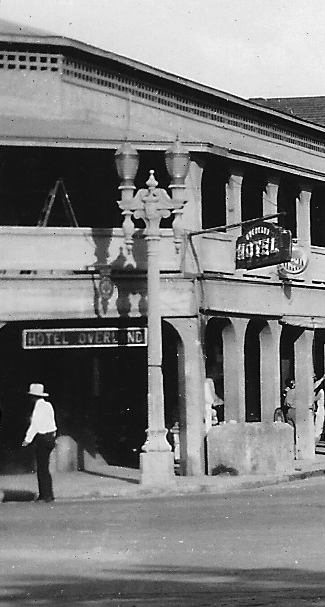
When the light pole was installed, the first Neon side was moved to the Fremont Street side of the hotel
Finally, the sign was removed, along with the trees, and replaced with two larger Neon signs. One on the Main Street side and a second large sign on the Fremont Street side.
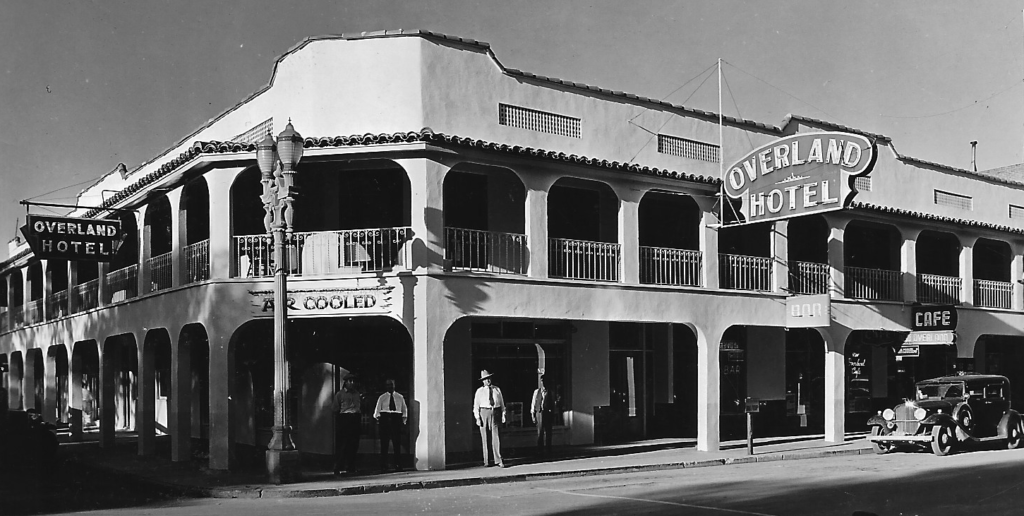
Up to the mid-1920s, the primary source of transportation in and out of Las Vegas was the Union Pacific Railroad.
Starting in the mid-teens, work began to improve the roads between Utah and California. Until the early 1920s, the roads were a small step above trails.
Then in 1926, the federal government created U.S. Highway 91, and bus travel became part of the transportation options, in and out of Las Vegas.
Coming in from southern California, through Nevada, and into Utah, the highway was paved. Paved in terms of the 1920’s definition; leveled, add oil, add gravel, and oil again.
Driving into Las Vegas from Los Angeles highway heading south on 5th Street, (Now Las Vegas Boulevard) then a zig-zag west on Fremont Street to Main Street and turn north to Salt Lake City; 5th, Fremont, Main Streets, all U.S. Highway 91.
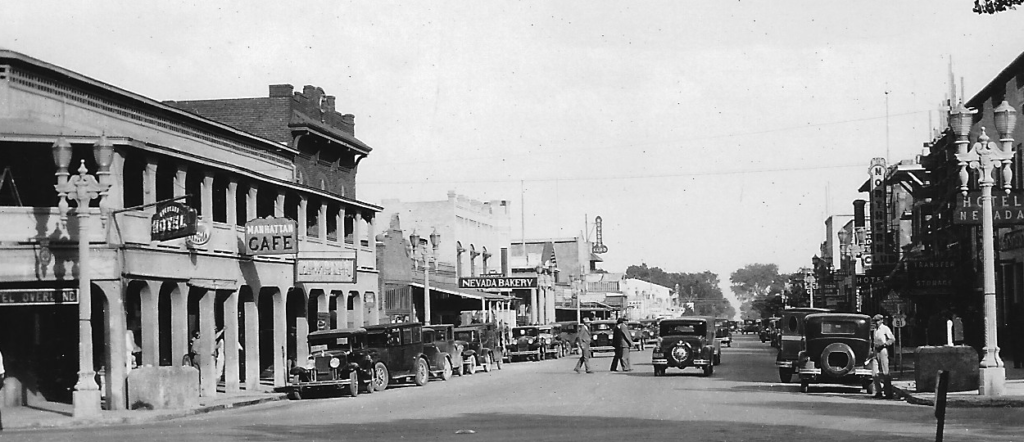
A wide shot of Fremont Street showing three of the 4 first Neon signs in Las Vegas as well as a U.S. Highway 91 sign. ca. 1930
By the late 1920’s thousands of cars, a year traveled the highway through Las Vegas.
Several clubs and so-call soft drink emporiums were operating on the first two blocks of Fremont.
The two main operations where you could have a ‘drink’ and gamble legally at poker, and pull a few slot machine handles, were the Northern and the Las Vegas Clubs.
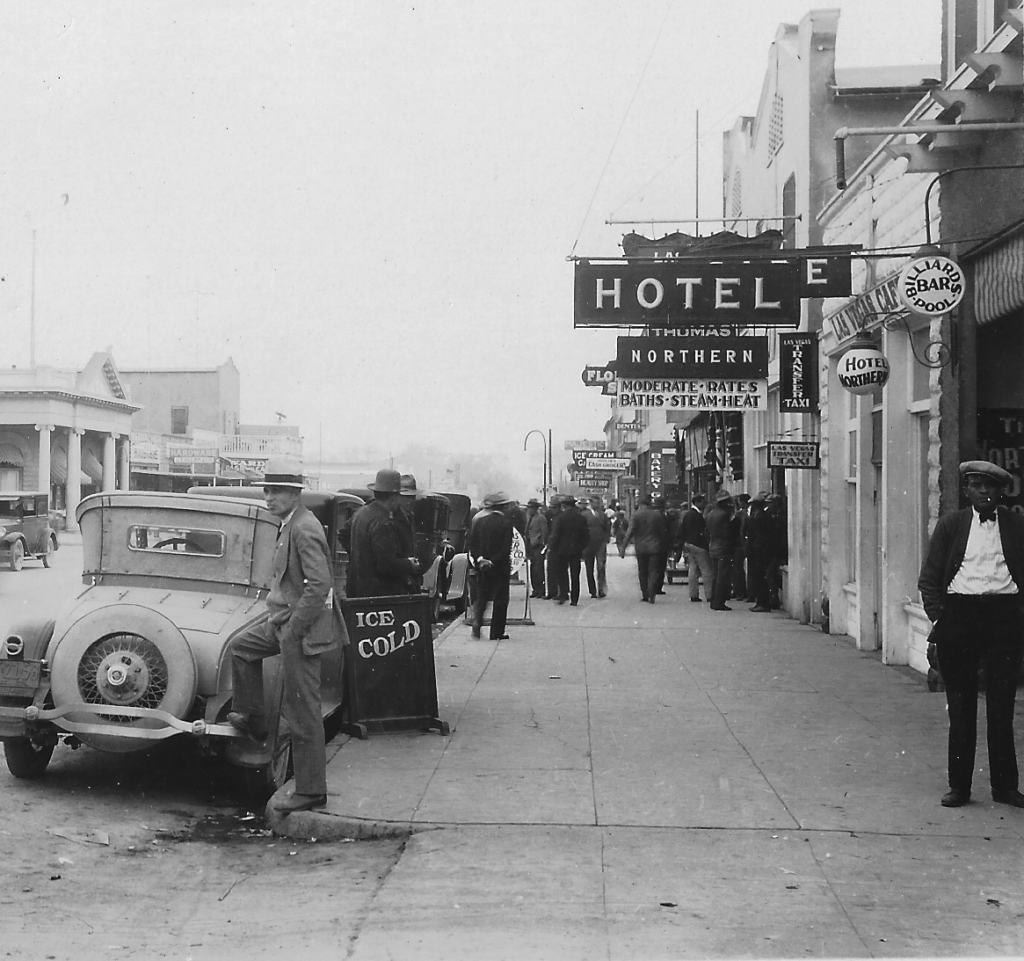
Based on the automobile’s license plate, this photograph is from early 1929.
With the dam legislation approved, new businesses were moving in and in many cases proving competition to existing operators, including the gaming clubs.
A couple of clubs would be built out past the city limits on U.S. 91. The first in 1929 would be the Red Rooster, followed by the Pair O’ Dice.
Another early riser was Prosper J. Goumond, and his crew of experienced gamblers from Ely. In late spring of 1929, they moved to Las Vegas bought the lot at 118 Fremont, and built the Boulder Club.
Just before Goumond arrived, two Neon sign companies opened for business in the city. With his arrival, the summer and fall of 1929 would mark the beginning of the Las Vegas Neon wars.
The first known neon sign company in Las Vegas opened for business in February of 1929, as the Boski Electric Company. When its owner Earl K. Bruce convinced his two brothers to join him, the name quickly changed to the Bruce Brothers electric company; “live wire electricians.”[xiii]
Then the brothers cut a deal with the largest Neon firm in the world, Claude Neon Signs. [xiv]
The Claude Neon sign company was owned by Georges Claude, a French inventor. Claude was a pioneer in the development of neon lighting. He would patent his inventions in the U.S. and fought many court battles to preserve his ideas.
Claude is considered to be the first person “to apply an electrical discharge to a. sealed tube with neon as the gas creating the first neon lamp.” [xv]
The same day the Bruce Brothers announced their deal with Claude the Las Vegas Neon Electric Sign Company opened its doors.
Barrett and his partners said they were “here to stay and will handle work on signs of any size or class” as well as “providing servicing after the installation,”
The company opened its shop at 18 Bridger Street with what the partnership called “full equipment.” [xvii]
Bruce Brothers and Las Vegas Neon would become part of Las Vegas’ first battle of the Neon signs.
The fight would start with ‘my sign is larger than your sign,’ and over the years would develop into an artistic, and technological marketing game of who can attract the most attention.
Downtown Las Vegas would combine its Neon and western theme and become known in the 1940’s as “Glitter Gulch.”
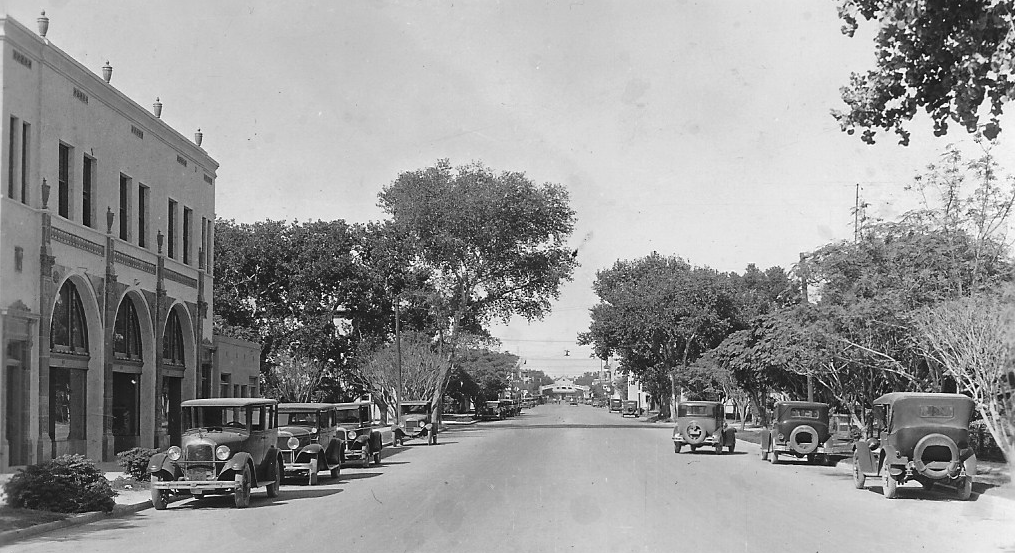
Looking west at the tree-lined third street of Fremont with railroad depot on background, the Golden Hotel in early 1929 before its Neon sign was installed.
The Las Vegas Neon Electric Sign Company on the night of April 29, 1929, finished its first major installation at the Hotel Golden. [xviii]
The hotel, owned by Mrs. Thomas R. Hodgens, was located at 323 Fremont on the south side at the corner of 4th and Fremont.
Beyond the fact that it was described as an eight-foot-long Neon sign, no images or other details of the sign have been uncovered.
The story announcing the installation included the following sentence, “When the eight-foot-long sign was turned on, Mrs. Hodges expressed pride in ownership of one of the state-of-the-art electric signs.” [xix]
While Las Vegas Neon was working on the Hotel Golden sign, the Bruce Brothers were working on an even bigger sign for the Boulder Club. [xx]
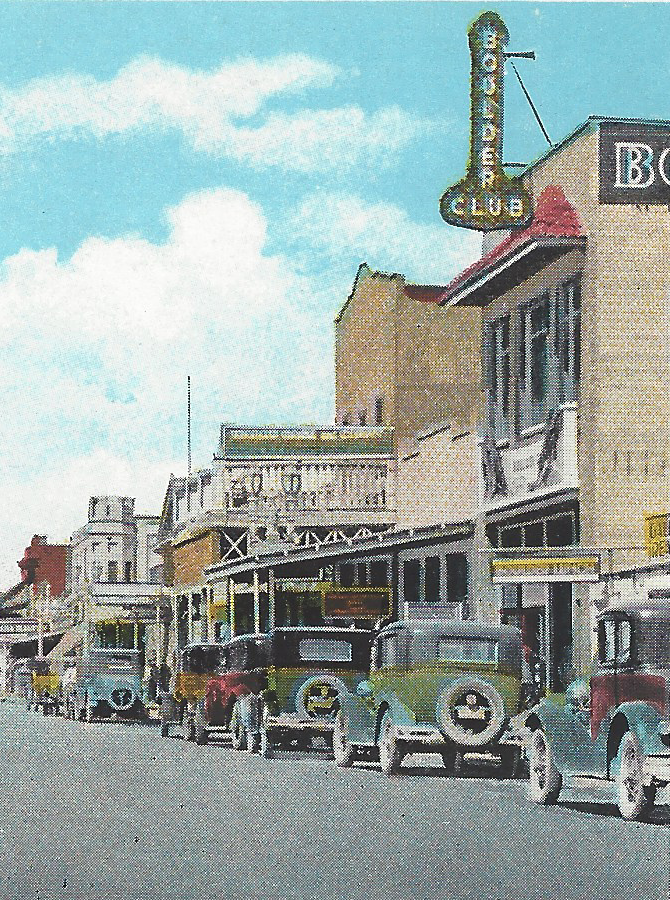
This early 1931 post card shows the sign was painted green. And while artists at the post card printing plant often made their own artistic decisions, they were provided with color details by the company ordering the post cards. In this case, it was William Ferron or his staff. He owned drug stores in Las Vegas and at the time was the largest post card publisher in southern Nevada.
Since the new club was in the middle of the business district Goumond decided he needed a sign that could be seen at the railroad depot, and drivers traveling on U.S. 91.
Opened on Saturday night of July 27, 1929, with gaming tables on the west side of the long two-story building and the bar and a few “nickel-in-the-slot-machines” on the east side, Goumond called his place, “Nevada’s Finest Men’s Club.”
His advertisements would not mention gambling, as that was covered in the word “Club.” Goumond did point to his “Soda Fountain, Sandwiches, Candies, Cigars, Cigarettes, and Tobaccos.” [xxi]
On opening day, the Las Vegas Age promoted the Boulder Club saying the new business was “crowned with its great twelve-foot Neon sign.” [xxii]
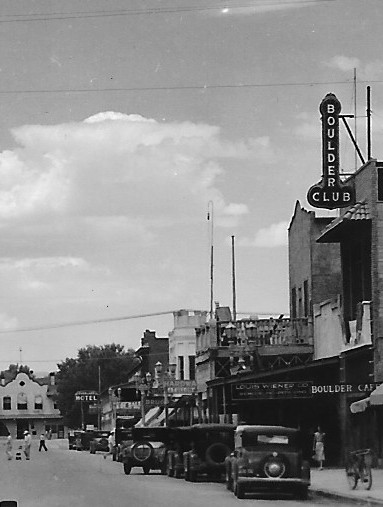
The Boulder Club’s sign was four feet longer than the Hotel Golden’s 8-foot sign two blocks east.
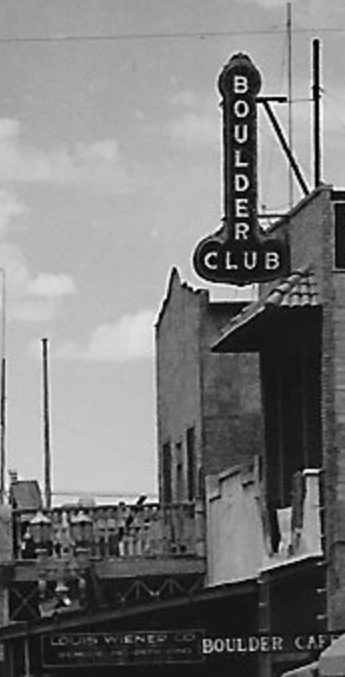
The vertical double-sided sign on the Boulder Club extended out from the top of the second floor up past the roofline.
And those with sharp eyes, at the bottom of the photograph, is the “Louis Wiener” clothing store.
The Wiener’s son, Lou would go on to become well known as first, the attorney for the City of Las Vegas and later in private practice as Benjamin Siegel’s attorney.
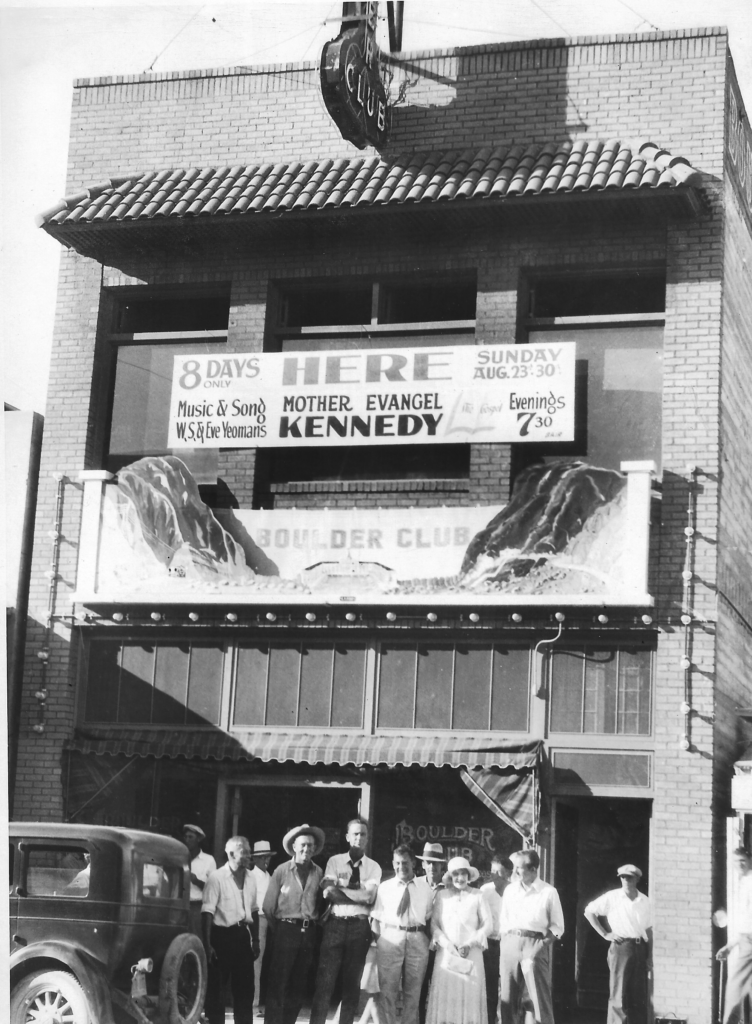
The original sign was still up when this photograph was taken in late August 1931. The photograph provides details of where and how the Boulder Club Neon sign was installed.
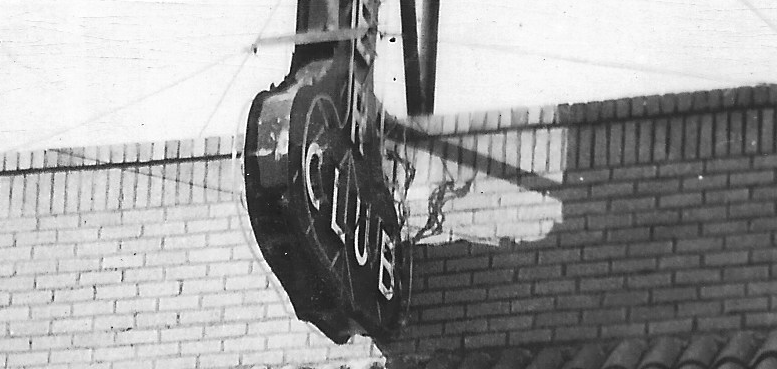 As the Bruce Brothers were assembling and installing the Boulder Club sign, Barrett’s Las Vegas Neon Electric Sign Company had secured a contract from the Northern Club.
As the Bruce Brothers were assembling and installing the Boulder Club sign, Barrett’s Las Vegas Neon Electric Sign Company had secured a contract from the Northern Club.
Owned by the Stocker family the Northern Hotel and Club, located at 15 Fremont Street, wanted the largest Neon sign in town.[xxiii]
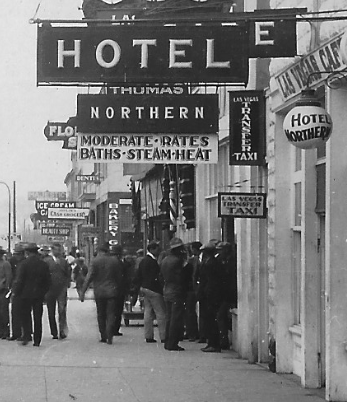
The need for space to build the large Northern sign required the company to move from its Bridger Street location to Third and Carson. Two weeks after the Boulder Club sign began to glow, the Las Vegas Neon company owners said they were working on a “big new sign for the Northern Club.” [xxiv] The announcement said the sign was “almost finished and ready for erection.” [xxv]
The Las Vegas Age reported in its Saturday, August 24, 1929 edition, “The new sixteen-foot neon electric sign at the Northern Club will be flashing tonight, according to Barrett and Clout, builders of the sign. It is the largest neon sign in the city and will flash the word “The” and then “Northern Club.”
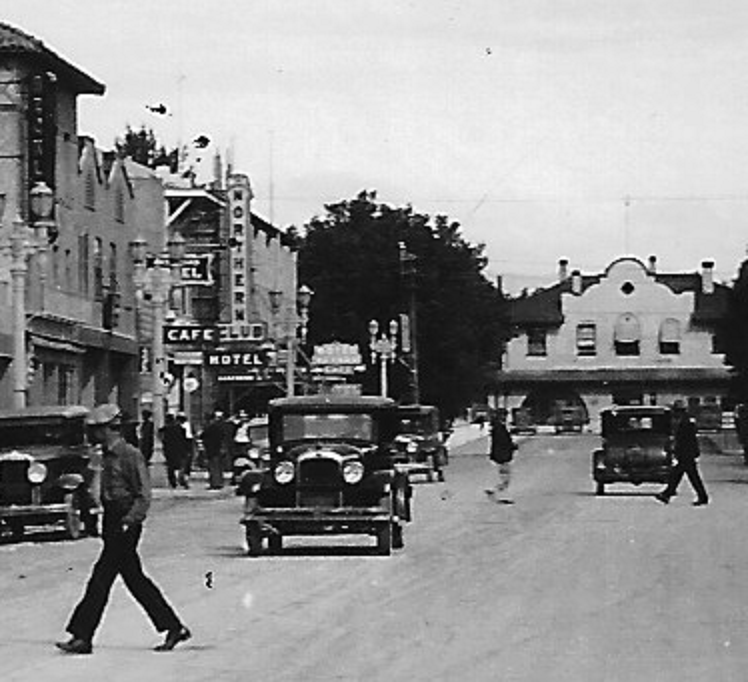
This circa 1930 view, shows the east side of the two side sign.
Once again, the Neon colors were not mentioned.
From the photographs, it appears the sign was painted white or yellow.
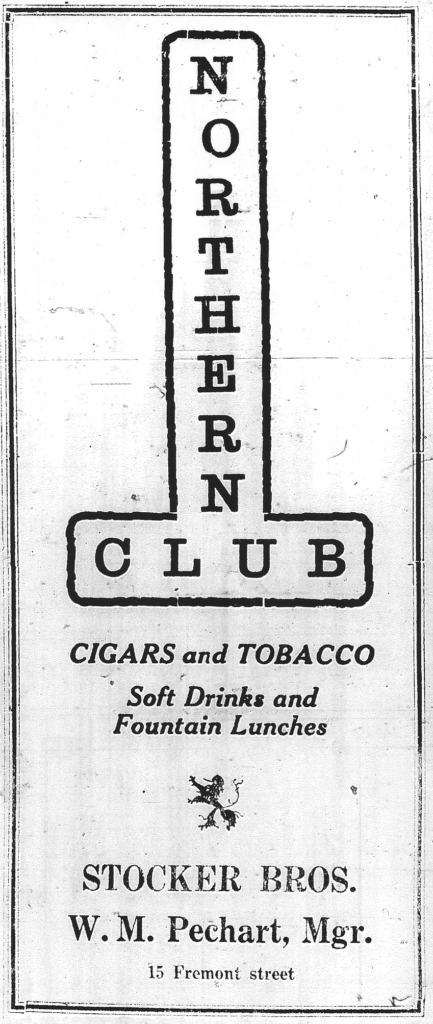
Two months later, in October without the “THE” an advertisement appeared in the Las Vegas Age with a graphic of the Stocker’s new sign.
The one-time ad was an unusual move for the Stockers who normally did not use the local newspapers to promote their club.
While it would be the fourth Neon sign to light up Fremont Street, for a while, it would be the tallest and the flashiest.
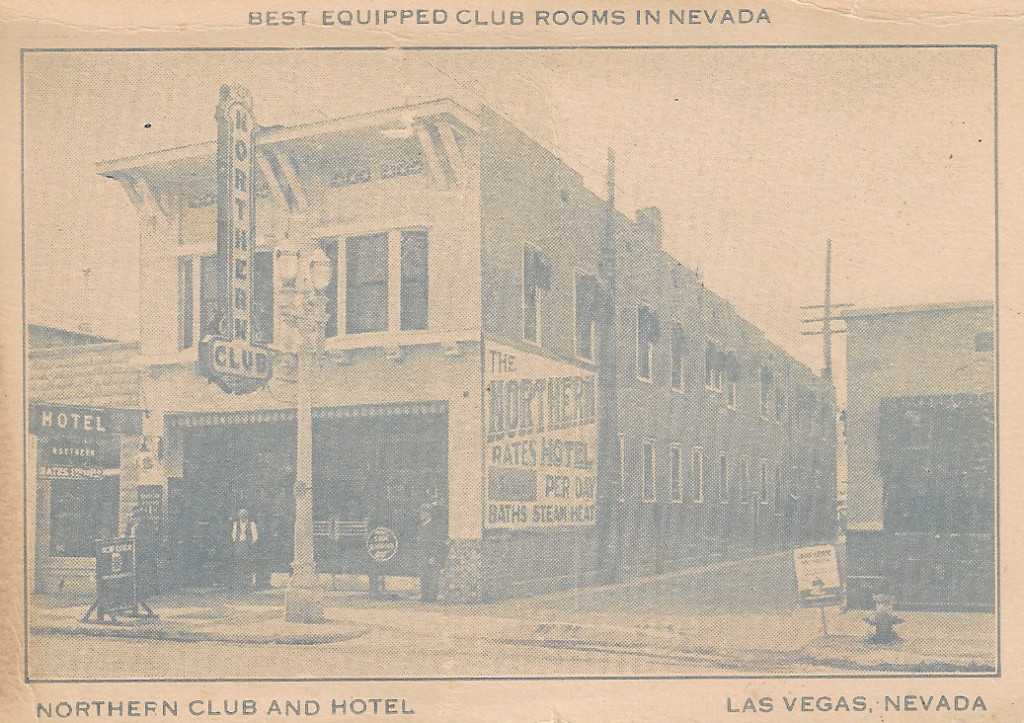
This late 1929, early 1930 post card shows the Northern’s first neon sign, as well as being the site for the city’s new light poles.
It appears the only Neon sign the Bruce Brothers installed in 1929 was at the Boulder Club. Over the next couple of years, the company would change management and focus on electrical work. That would change after meeting Thomas Young.
At the end of 1929, the Las Vegas Neon Sign Company had built and installed Neon signs at the Golden Hotel, Gateway Hotel, Northern Club, M. W. Davis Jeweler, Beckley’s, Professional Pharmacy, and the Mission Cigar Store.
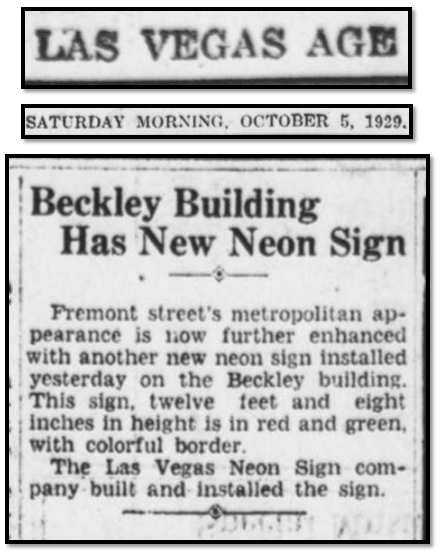
The sign company also said they were the “contractors for the new Las Vegas High School electrical wiring” system. [xxvi]
Gateway Hotel and Main and Stewart Streets
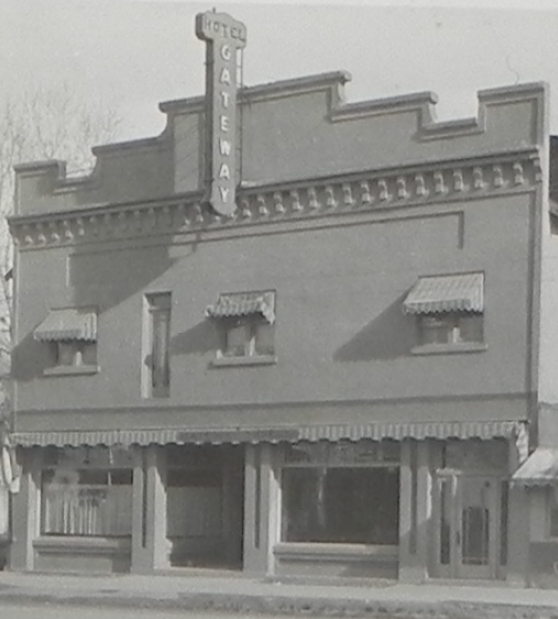
The battle over the biggest and brightest Neon sign would continue into the 1930s.
With gambling legalized in 1931 and clubs opening up and down Fremont, new hotels being built and with the construction of the dam well underway 1932 would become a milestone in the history of Neon in Las Vegas.
At some point before May 1, 1932, the Bruce Brothers Electric Company became simply the “Nevada Electric Company,” with A. M. Bruce as the Manager. [xxvii]
In March of 1932, Thomas Young, of the Young Electric Sign Company set up an office in the brand new Apache Hotel at Second and Fremont Streets.
Young said at the time, he was “pleased to announce our entering Las Vegas.” [xxviii]
As part of the initial business plan, Young also said he was working directly with the Nevada Electric Company. [xxix]
Young’s Neon work continues to glow at http://www.neonmuseum.org/about/the-collection/neon-boneyard
Looking for early Neon sign images along Fremont Street, we began to notice as Neon arrived, the trees began to disappear.
Until a Neon sign is found in Las Vegas before September 28, 1928, the Overland Hotel holds the honor of having the first Neon sign in Las Vegas.
Here is a list of the first eleven known Neon signs in Las Vegas 1928-1929 and when each sign began to glow.
- Overland Hotel, week of September 28, 1928.
- Golden Hotel, April 29, 1929.
- Boulder Club, July 27, 1929.
- Northern Club, August 24, 1929.
- W. Davis Jeweler, Summer-Fall, 1929.
- Mission Cigar, Fall, 1928.
- La Salle, after August 24, 1929.
- Oak Hotel, after August 24, 1929
- Gateway Hotel, Fall, 1929.
- Professional Pharmacy, Fall, 1929.
- Beckley’s Department Store, October 4, 1929
[i] “Celebration at Las Vegas, Nev.” December 21, 1928, Associated Press.
[ii] “New Management for Overland Hotel,” February 10, 1928, Las Vegas Age, page two.
[iii] The newspaper would be the Las Vegas Review until took over the “Las Vegas Journal” in July of 1929 to become the Las Vegas Review-Journal.
[iv] “Hotel has New Sign,” September 28, 1928, Las Vegas Review, Page one.
[v] “New Motel Elwell” by Charles P. Squires, January 25, 1948, Las Vegas Evening Review-Journal & Age, page 12B.
[vi] “New Motel Elwell” by Charles P. Squires, January 25, 1948, Las Vegas Evening Review-Journal & Age, page 12B.
[vii] “New Motel Elwell” by Charles P. Squires, January 25, 1948, Las Vegas Evening Review-Journal & Age, page 12B.
[viii] “New Motel Elwell” by Charles P. Squires, January 25, 1948, Las Vegas Evening Review-Journal & Age, page 12B.
[ix] “New Motel Elwell” by Charles P. Squires, January 25, 1948, Las Vegas Evening Review-Journal & Age, page 12B.
[x] “Las Vegas Neon Electric Sign Co.” display advertisement, January 1, 1930, Las Vegas Review-Journal, page four.
[xi] “Observations,” by Charles P. “Pop” Squires, September 12, 1953, Fabulous Las Vegas magazine, Page 25.
[xii] “Observations,” by Charles P. “Pop” Squires, September 12, 1953, Fabulous Las Vegas magazine, Page 25.
[xiii] “Boski Electric Opens Temporary Quarters,” February 26, 1929, Las Vegas Age, Page two. “Electric Firm Has Two new Members,” March 5, 1929, Las Vegas Age, page one.
[xiv] “Neon Signs Have Agents in Vegas,” April 5, 1929, Las Vegas Review-Journal, page one.
[xv] http://neonlibrary.com/neon_history_2.html
[xvi] 1930 United States Federal Census, Las Vegas, Clark, Nevada, National archives and records administration, T626.
[xvii] “Hotel Golden’ s New Neon Sign Installed,” April 30, 1929, Las Vegas Age, Page one
[xviii] “Hotel Golden’ s New Neon Sign Installed,” April 30, 1929, Las Vegas Age, Page one
[xix] “Hotel Golden’ s New Neon Sign Installed,” April 30, 1929, Las Vegas Age, Page one
[xx] “Boulder Club Holds Grand Opening T’Day,” July 27, 1929, Las Vegas Age, page one.
[xxi] Display advertisement, Boulder Club, July 27, 192, Las Vegas Review, page three.
[xxii] “Boulder Club Holds Grand Opening T’Day,” July 27, 1929, Las Vegas Age, page one.
[xxiii] “New Northern Club neon Sign Completed,” August 24, 1929, Las Vegas Age, Page three.
[xxiv] “Neon Sign Company is now in New Location,” August 13, 1929, Las Vegas Age, page three.
[xxv] “Neon Sign Company is now in New Location,” August 13, 1929, Las Vegas Age, page three.
[xxvi] “New Northern Club Neon Sign Completed,” August 24, 1939, Las Vegas Age, page three.
[xxvii] “Electric Company, Inc.,” display advertisement, May 1, 1932, Las Vegas Age, Page two.
[xxviii] “Young Electric Sign Company,” display advertisement, March 29, 1932, Las Vegas Evening Review-Journal, page six.
[xxix] “Young Electric Sign Company,” display advertisement, March 29, 1932, Las Vegas Evening Review-Journal, page six.
